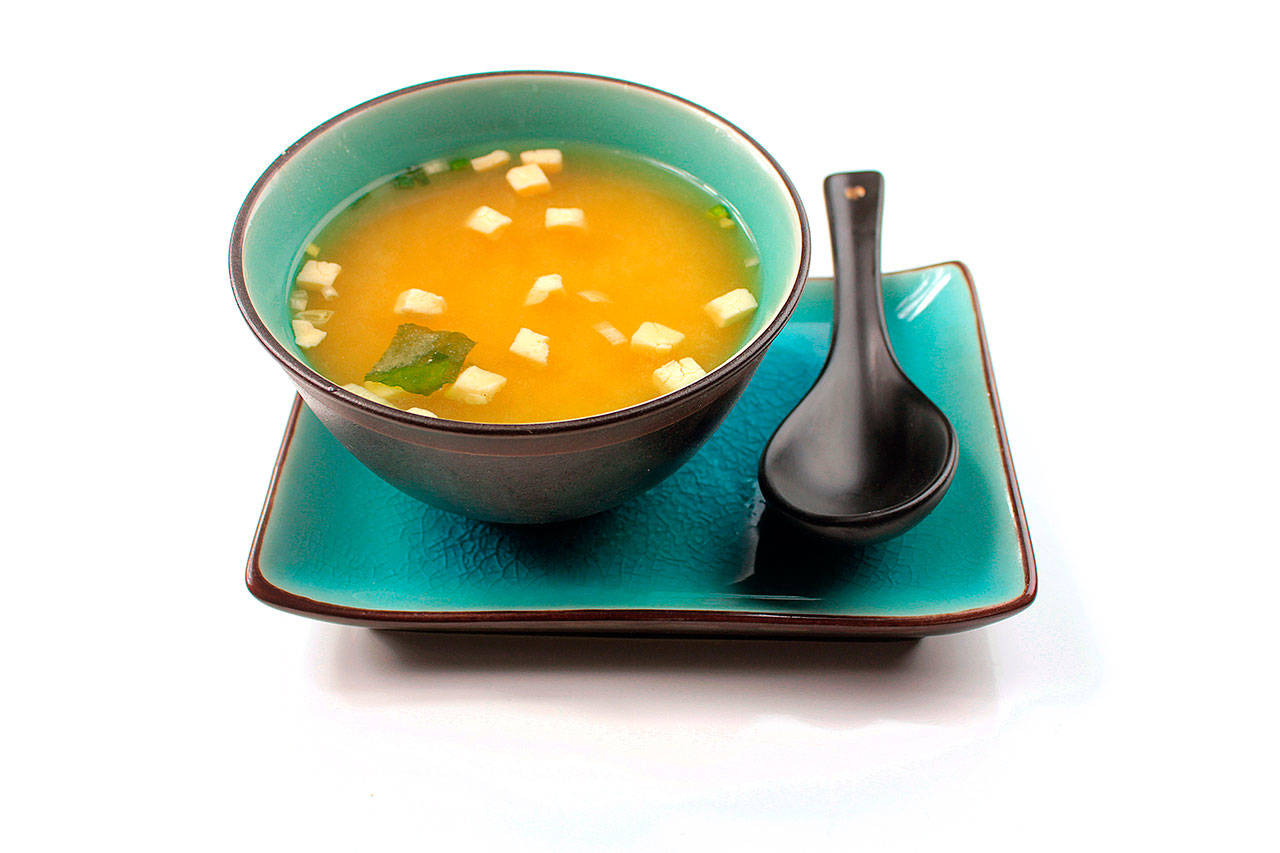By Carole Kotkin / Miami Herald
Have you seen those plastic tubs of miso paste in Asian markets or supermarkets and wondered what to do with it?
It’s miso, one of the backbones of Japanese cooking and one of my favorite condiments to have on hand. I love the sweet-salty-savory-nutty depth of flavor that it adds when stirred into dishes.
Miso is a paste made from a mixture of soybeans, rice, barley or other grains that have been fermented with salt, water and a fungus. Miso is teeming with protein, B vitamins and minerals, and rich in glutamates, which give food that meaty taste known as umami. While most of us recognize miso paste for its use in Japanese miso soup (who hasn’t been on the miso soup diet?), it also adds a unique flavor to sauces and marinades, baked tofu or vegetable dishes.
There are more than 1,000 types of miso. They differ in color, aroma and taste based on where the miso was made, the type of fungus used and the length of fermentation. A broad rule is that flavor deepens as the color gets darker.
Among the most common miso pastes, white miso is the mildest variety and is great for salad dressings and light sauces. Red or dark brown miso is fermented the longest; and it is concentrated and intense and best used sparingly in recipes that can stand up to its bold and pungent flavor. Yellow or light brown miso lies between these two types and is of medium strength. It is good used in soups, marinades and glazes.
Asian ginger-miso vinaigrette is an excellent change from the usual olive oil-vinegar salad dressing. To make the vinaigrette pour 1 tablespoon each of canola oil, dark sesame oil, white miso paste and rice vinegar into a blender and add 1 garlic clove, half a teaspoon of sugar, 2 teaspoons of grated fresh ginger and pinches of salt and pepper. Blend until smooth and pour over salad greens, grilled fish or sauteed spinach.
A mix of equal parts miso and mayonnaise makes the perfect topping for any sandwich you can create. Barbecue sauce flavor is enhanced with a little miso stirred in.
Once opened, miso paste should be covered with plastic wrap and kept in the refrigerator. It will keep for about six months; discard if it dries out or changes color.
The following recipes are adapted from “Hiroko’s American Kitchen” by Hiroko Shimbo, a world renowned chef of Japanese cuisine. The book published by Andrews McMeel Publishing ($24.99) goes over ways to incorporate Japanese flavors into American cooking.
Miso shrimp scampi
Gloria Ferrer’s Brut Rose ($30) is an exceptionally versatile sparkling wine that is an excellent complement to spicy Asian dishes in particular. Its bright strawberry and red cherry flavors and mineral finish accentuates the spices in this dish.
Hiroko writes: “This is not the typical garlic butter sauced shrimp dish that we all know. In this delightful variation on an old standard, shrimp are cooked and coated with spicy miso sauce that has been highly seasoned with fragrant ginger, garlic and scallion. The resulting dish is absolutely delicious. When you can buy fresh shrimp in shells with the head attached, cook them whole without shelling or beheading.”
1 pound medium shrimp, shelled and deveined, with tail attached
2 teaspoons cornstarch
2 teaspoons plus 2 tablespoons cold water
½ teaspoon sea salt
3 tablespoons spicy miso sauce (recipe below)
¼ cup sake (rice wine) or water
4 teaspoons sugar
3 scallions
2 teaspoons canola oil or vegetable oil
1½ tablespoons minced garlic
2 teaspoons minced ginger
Place the shrimp with the cornstarch, 2 teaspoons of the water, and salt in a large bowl and toss well to coat. Let stand for 10 minutes. Mix the spicy miso sauce, sake, sugar and the remaining 2 tablespoons water in a small bowl. Cut the scallions into very thin slices, separating the white and green parts.
Heat the canola oil in a skillet over medium-high heat, add the shrimp, and cook for 1 minute on each side, being careful not to move them so that they will brown a bit. Add the garlic, ginger and white part of the scallions to the skillet and cook for 20 seconds, or until fragrant, stirring. Add the prepared miso sauce mixture to the skillet, reduce the heat to medium-low, and cook the shrimp for 1 more minute.
Transfer the shrimp to a large platter. Garnish with the green part of the scallions and serve. Makes 4 servings.
Spicy miso sauce
Hiroko writes that this sauce is also great for stir-frying, braising, grilling and as a component of salad dressing. She recommends it as a complement to vegetables and proteins that have strong flavor characteristics, such as broccoli, kale, cauliflower and beef.
1 cup aged brown miso
½ cup plus 1 tablespoon sugar
¾ cup mirin (sweet cooking wine)
⅓ cup plus 2 tablespoons sake (rice wine)
¼ cup lemon juice
1 to 2 teaspoons red pepper flakes
Place the miso, sugar, mirin and sake in a medium pot and whisk until smooth. Place the pot over medium heat and bring it to a simmer. Cook the mixture, stirring constantly, for 4 to 5 minutes. Add the lemon juice and cook for 8 minutes, stirring occasionally. Turn off the heat, add the red pepper flakes, and stir. Transfer the sauce to a clean freezer container. Cover the jar with a lid and store it in the freezer.
Talk to us
> Give us your news tips.
> Send us a letter to the editor.
> More Herald contact information.

























